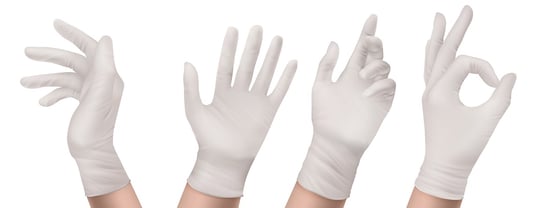When it comes to cleanroom consumables, a product’s recommended shelf life or specific expiration date is a question customers commonly ask. Since there are different kinds of cleanroom consumables, such as gloves, apparel, wipers, mops, paper products, tacky mats, and more, there are also different recommendations for shelf life or specific expiration dates. Let’s discover the key factors that determine the overall longevity of cleanroom consumables.
Optimize Product Life With Proper Storage
There are no standardized expiration dates for the majority of cleanroom consumables — provided that proper storage conditions are met. Valutek’s storage recommendations include storing cleanroom consumables in their original packaging away from UV light (including fluorescent lights) and storing them in a climate-controlled and humidity-controlled environment. It’s also important to note that cleanroom consumables perform their best at room temperature.
The Exceptions: Sterile Products And Latex Gloves Have Finite Shelf Lives
Certain types of gloves and sterile products, however, are the exception when it comes to expiration dates. Their shelf life can vary depending on several factors — storage, material, and intended use of the gloves. Specifically, any product that has undergone a sterilization process or any glove made with latex has a finite shelf life, for different reasons.
Sterile consumables (commonly gloves, wipers, and apparel) in their original packaging have a recommended expiration date of 5 years from the date of manufacture (subject to proper storage conditions and noted on the Valutek Certificate of Analysis), due to the fact that these products retain their sterility for only a finite amount of time.
Latex gloves in their original packaging also have a limited shelf life since latex is an organic material and does eventually degrade. Valutek’s recommended expiration date of 5 years from the date of manufacture for all latex glove products is noted on the Certificate of Analysis.
Nitrile gloves (non-sterile) that are commonly used in cleanrooms do not have these same types of definitive expiration dates. While nitrile gloves do not have official expiration dates, it is still important to keep in mind that their efficacy can be affected by a variety of factors, such as exposure to certain chemicals or extreme temperatures.
All gloves that are exposed to UV light (even from fluorescent lights) tend to degrade at a faster rate than gloves that are stored in a dark area or closed receptacle, away from UV light. If you have fluorescent lights in your glove storage area, it’s recommended that the stock is routinely rotated to avoid accelerated aging and possible loss of tensile strength.
How Can You Optimize The Shelf Life Of Cleanroom Consumables?
Proper storage is the key to optimizing the life of all your cleanroom products. Ask yourself these questions when reviewing your cleanroom consumable storage:
-
Are you storing at room temperature?
If not, and the storage temperature is significantly higher or lower than ambient operating temperatures, the product may experience accelerated degradation and/or may not perform as expected. By storing your cleanroom consumables at room temperature, you can help optimize their life. This applies to all cleanroom consumables.
-
Are you storing away from UV light?
If the product is not in a dark area, invisible damage by UV light may occur. By storing your cleanroom consumables in a dark spot or receptacle, you can help extend their shelf life. This applies to all gloves and to most apparel containing elastic-stitched openings (i.e., bouffant caps, face masks, shoe covers, and more). -
Is the packaging undamaged?
Vacuum-sealed packaging improves the shelf life of cleanroom consumables. During storage, regular visual inspection of the vacuum-sealed packaging will confirm whether the products have been compromised. Valutek recommends regular visual inspections to avoid surprises before a product is moved into use for operators. This applies to gloves and any other consumable that is in vacuum-sealed packaging. -
Are you storing it in the proper orientation?
It is important to avoid stacking heavy objects on top of any packaged cleanroom products, as this can cause them to become misshapen, compromise bag seals, and may affect their performance. When palletized for storage or transport, never “double stack” pallets. Adhesive mats in particular must be stored flat, or their bonding properties and structure will be negatively affected when put into use. By storing your cleanroom consumables in their proper orientation shown on the box, you can help extend their shelf life. This applies to all cleanroom consumables.
While there are many variables that come into play during the storage of cleanroom consumables, customers that are aware of and plan for proper storage will help optimize the shelf life of many products. By checking the manufacturer's recommendations and storing cleanroom products properly, you can help ensure their effectiveness, optimize their performance and shelf life, reduce waste, and maintain your critical cleanroom standards.
Explore More Resources
How Packaging Effects the Performance of Cleanroom Wipers
Non-Compliant Cleanroom Packaging: A Recipe for Contamination Control

Valutek
Valutek is one of the first and few manufacturers to offer a full product portfolio of best-in-class cleanroom products. Since 1988, our controlled environment consumables are helping leading organizations operate their cleanrooms in a consistently stable state.
Related Articles
- Valutek

- 13 April 2023
Cleanroom Wiper Selection Fundamentals: Pre-saturated Solutions
For most cleaning processes, the cleaning staff or operator applies a cleaning solution to a dry...
- Valutek

- 21 February 2023
Cleanroom Glove Selection Fundamentals - Part I : What You Need to Know
Selecting the most appropriate cleanroom glove can seem complicated. If you are trying to match...
- Valutek

- 29 November 2023
Product Selection Secrets: How Matched Sets Define Cleanroom Cleanliness
Manufacturers often offer matched sets of products that are designed to work together for...


